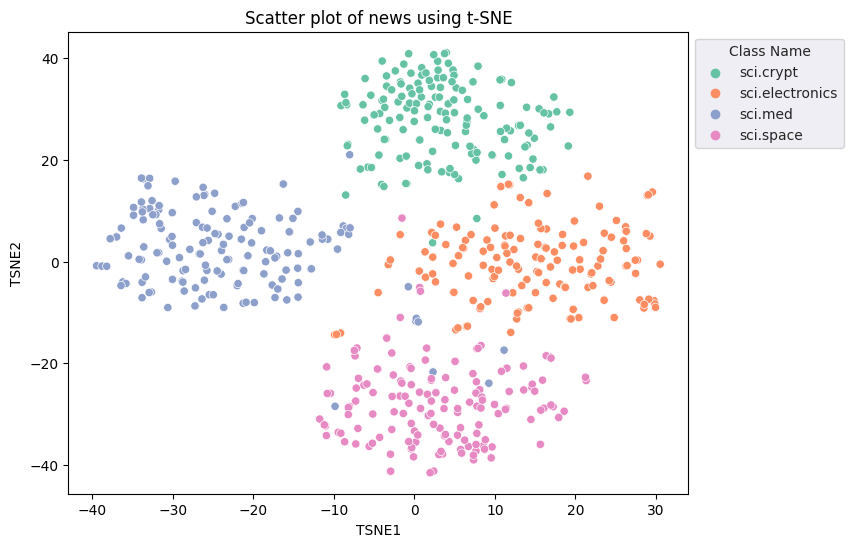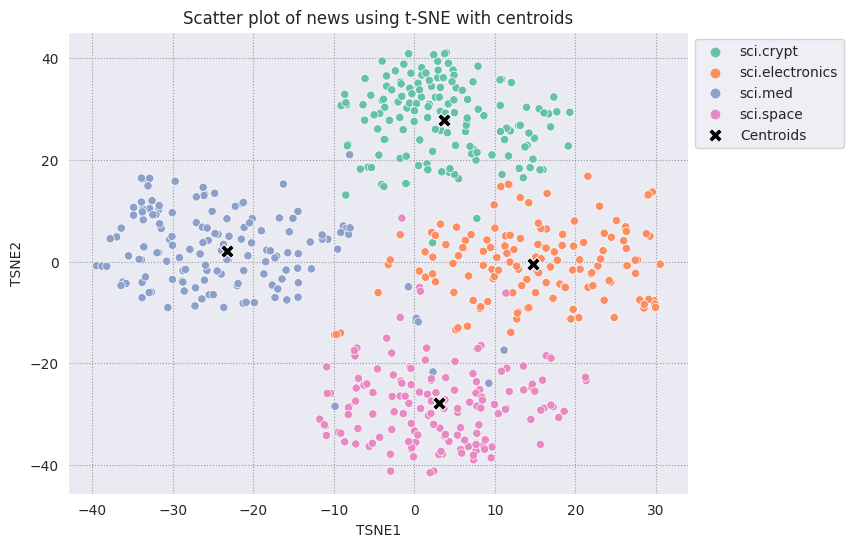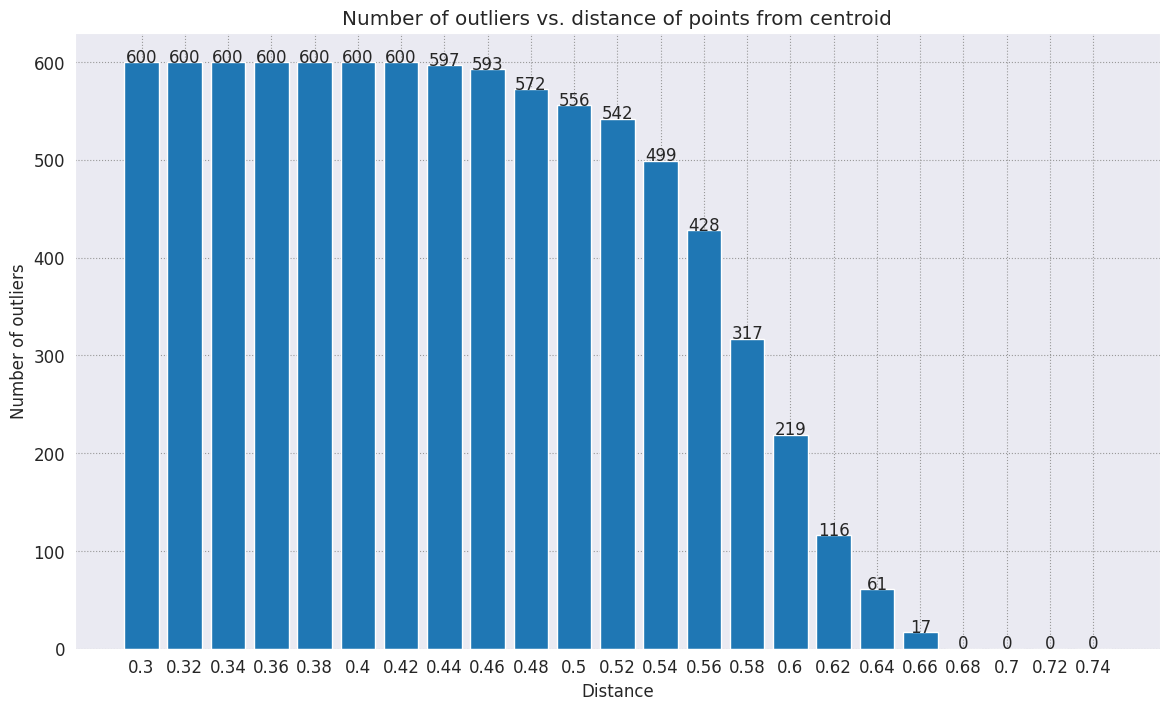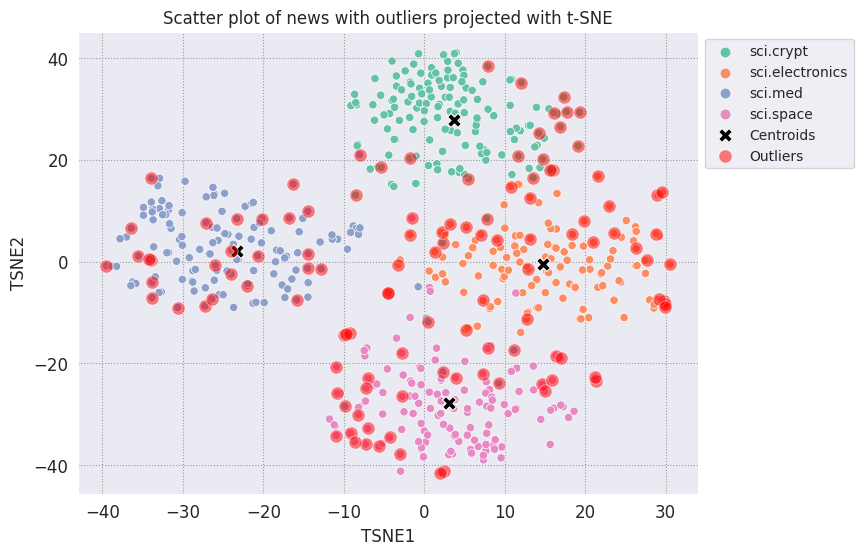|
|
 تجربة ورقة ملاحظات Colab تجربة ورقة ملاحظات Colab
|
 الاطّلاع على ورقة الملاحظات على GitHub الاطّلاع على ورقة الملاحظات على GitHub
|
نظرة عامة
يشرح هذا الدليل التوجيهي كيفية استخدام التضمينات من Gemini API لرصد القيم الاستثنائية المحتمَلة في مجموعة بياناتك. يمكنك إنشاء تمثيل مرئي لمجموعة فرعية من مجموعة بيانات Newsgroup البالغ عددها 20 مجموعة باستخدام t-SNE واكتشاف القيم الاستثنائية خارج نطاق جغرافي محدد للنقطة المركزية لكل مجموعة عنقودية فئوية.
لمزيد من المعلومات حول بدء استخدام التضمينات التي يتم إنشاؤها من Gemini API، يُرجى الاطّلاع على مقالة التشغيل السريع على Python.
المتطلبات الأساسية
يمكنك تشغيل دليل البدء السريع هذا في Google Colab.
لإكمال هذه البدء السريع في بيئة التطوير الخاصة بك، تأكد من أن بيئتك تفي بالمتطلبات التالية:
- Python 3.9+
- يجب تثبيت
jupyterلتشغيل ورقة الملاحظات.
ضبط إعدادات الجهاز
أولاً، عليك تنزيل مكتبة Gemini API Python وتثبيتها.
pip install -U -q google.generativeai
import re
import tqdm
import numpy as np
import pandas as pd
import matplotlib.pyplot as plt
import seaborn as sns
import google.generativeai as genai
# Used to securely store your API key
from google.colab import userdata
from sklearn.datasets import fetch_20newsgroups
from sklearn.manifold import TSNE
الحصول على مفتاح واجهة برمجة التطبيقات
لكي تتمكّن من استخدام Gemini API، يجب أولاً الحصول على مفتاح واجهة برمجة تطبيقات. إذا لم يكن لديك مفتاح، يمكنك إنشاء مفتاح بنقرة واحدة في Google AI Studio.
الحصول على مفتاح واجهة برمجة التطبيقات
في Colab، أضِف المفتاح إلى مدير المفاتيح السرّية ضمن "🔑". في اللوحة اليمنى. أدخِل الاسم API_KEY.
بعد حصولك على مفتاح واجهة برمجة التطبيقات، أرسِله إلى حزمة تطوير البرامج (SDK). هناك طريقتان لإجراء ذلك:
- ضَع المفتاح في متغيّر البيئة
GOOGLE_API_KEY(ستتولى حزمة تطوير البرامج (SDK) استلامه تلقائيًا من هناك). - تمرير المفتاح إلى
genai.configure(api_key=...)
genai.configure(api_key=GOOGLE_API_KEY)
for m in genai.list_models():
if 'embedContent' in m.supported_generation_methods:
print(m.name)
models/embedding-001 models/embedding-001
إعداد مجموعة البيانات
تضم مجموعة البيانات النصية لـ 20 مجموعة إخبارية 18,000 مجموعة إخبارية حول 20 موضوعًا مقسّمًا إلى مجموعات تدريب واختبار. يعتمد التقسيم بين مجموعات بيانات التدريب والاختبار على الرسائل المنشورة قبل وبعد تاريخ محدد. يستخدم هذا البرنامج التعليمي المجموعة الفرعية للتدريب.
newsgroups_train = fetch_20newsgroups(subset='train')
# View list of class names for dataset
newsgroups_train.target_names
['alt.atheism', 'comp.graphics', 'comp.os.ms-windows.misc', 'comp.sys.ibm.pc.hardware', 'comp.sys.mac.hardware', 'comp.windows.x', 'misc.forsale', 'rec.autos', 'rec.motorcycles', 'rec.sport.baseball', 'rec.sport.hockey', 'sci.crypt', 'sci.electronics', 'sci.med', 'sci.space', 'soc.religion.christian', 'talk.politics.guns', 'talk.politics.mideast', 'talk.politics.misc', 'talk.religion.misc']
فيما يلي المثال الأول في مجموعة التطبيق.
idx = newsgroups_train.data[0].index('Lines')
print(newsgroups_train.data[0][idx:])
Lines: 15 I was wondering if anyone out there could enlighten me on this car I saw the other day. It was a 2-door sports car, looked to be from the late 60s/ early 70s. It was called a Bricklin. The doors were really small. In addition, the front bumper was separate from the rest of the body. This is all I know. If anyone can tellme a model name, engine specs, years of production, where this car is made, history, or whatever info you have on this funky looking car, please e-mail. Thanks, - IL ---- brought to you by your neighborhood Lerxst ----
# Apply functions to remove names, emails, and extraneous words from data points in newsgroups.data
newsgroups_train.data = [re.sub(r'[\w\.-]+@[\w\.-]+', '', d) for d in newsgroups_train.data] # Remove email
newsgroups_train.data = [re.sub(r"\([^()]*\)", "", d) for d in newsgroups_train.data] # Remove names
newsgroups_train.data = [d.replace("From: ", "") for d in newsgroups_train.data] # Remove "From: "
newsgroups_train.data = [d.replace("\nSubject: ", "") for d in newsgroups_train.data] # Remove "\nSubject: "
# Cut off each text entry after 5,000 characters
newsgroups_train.data = [d[0:5000] if len(d) > 5000 else d for d in newsgroups_train.data]
# Put training points into a dataframe
df_train = pd.DataFrame(newsgroups_train.data, columns=['Text'])
df_train['Label'] = newsgroups_train.target
# Match label to target name index
df_train['Class Name'] = df_train['Label'].map(newsgroups_train.target_names.__getitem__)
df_train
بعد ذلك، قم بعمل عينة من بعض البيانات عن طريق أخذ 150 نقطة بيانات في مجموعة بيانات التطبيق واختيار بضع فئات. يستخدم هذا البرنامج التعليمي فئات العلوم.
# Take a sample of each label category from df_train
SAMPLE_SIZE = 150
df_train = (df_train.groupby('Label', as_index = False)
.apply(lambda x: x.sample(SAMPLE_SIZE))
.reset_index(drop=True))
# Choose categories about science
df_train = df_train[df_train['Class Name'].str.contains('sci')]
# Reset the index
df_train = df_train.reset_index()
df_train
df_train['Class Name'].value_counts()
sci.crypt 150 sci.electronics 150 sci.med 150 sci.space 150 Name: Class Name, dtype: int64
إنشاء التضمينات
سنشرح في هذا القسم كيفية إنشاء تضمينات للنصوص المختلفة في إطار البيانات باستخدام التضمينات من Gemini API.
تغييرات واجهة برمجة التطبيقات على عمليات التضمين باستخدام نموذج التضمين -001
بالنسبة إلى نموذج التضمينات الجديد بما في ذلك 001-001، هناك مَعلمة نوع مهمة جديدة وعنوان اختياري (صالحة فقط مع نوع الإجراء (task_type)=RETRIEVAL_DOCUMENT).
تنطبق هذه المعلمات الجديدة فقط على أحدث نماذج التضمينات.وأنواع المهام هي:
| نوع المهمّة | الوصف |
|---|---|
| RETRIEVAL_QUERY | لتحديد أن النص المقدم هو طلب بحث في إعداد البحث/الاسترجاع. |
| RETRIEVAL_DOCUMENT | لتحديد أن النص المحدّد هو مستند في إعداد البحث/الاسترجاع. |
| SEMANTIC_SIMILARITY | لتحديد أنه سيتم استخدام النص المحدّد في التشابه النصي الدلالي (STS). |
| التصنيف | لتحديد أن التضمينات سيتم استخدامها للتصنيف. |
| التصنيف | لتحديد أن التضمينات سيتم استخدامها للتجميع العنقودي. |
from tqdm.auto import tqdm
tqdm.pandas()
from google.api_core import retry
def make_embed_text_fn(model):
@retry.Retry(timeout=300.0)
def embed_fn(text: str) -> list[float]:
# Set the task_type to CLUSTERING.
embedding = genai.embed_content(model=model,
content=text,
task_type="clustering")['embedding']
return np.array(embedding)
return embed_fn
def create_embeddings(df):
model = 'models/embedding-001'
df['Embeddings'] = df['Text'].progress_apply(make_embed_text_fn(model))
return df
df_train = create_embeddings(df_train)
df_train.drop('index', axis=1, inplace=True)
0%| | 0/600 [00:00<?, ?it/s]
خفض الأبعاد
بُعد الخط المتجه لتضمين المستند هو 768. لعرض كيفية تجميع المستندات المضمّنة معًا، ستحتاج إلى تطبيق تقليل الأبعاد، إذ يمكنك فقط عرض عمليات التضمين في مساحة ثنائية أو ثلاثية الأبعاد. يجب أن تكون المستندات المتشابهة من حيث السياق أقرب إلى بعضها البعض في المساحة مقارنةً بالمستندات غير المتشابهة.
len(df_train['Embeddings'][0])
768
# Convert df_train['Embeddings'] Pandas series to a np.array of float32
X = np.array(df_train['Embeddings'].to_list(), dtype=np.float32)
X.shape
(600, 768)
ستقوم بتطبيق منهج التضمين العشوائي الموزع (t-SNE) الموزَّع بتنسيق t-SNE لخفض الأبعاد. يقلل هذا الأسلوب من عدد الأبعاد، مع الحفاظ على المجموعات العنقودية (النقاط القريبة من بعضها تظل قريبة من بعضها). بالنسبة إلى البيانات الأصلية، يحاول النموذج إنشاء توزيع تكون عليه نقاط البيانات الأخرى "جيران" (مثلاً، تحملان المعنى نفسه). ثم يحسن دالة موضوعية للحفاظ على توزيع مشابه في التصور.
tsne = TSNE(random_state=0, n_iter=1000)
tsne_results = tsne.fit_transform(X)
df_tsne = pd.DataFrame(tsne_results, columns=['TSNE1', 'TSNE2'])
df_tsne['Class Name'] = df_train['Class Name'] # Add labels column from df_train to df_tsne
df_tsne
fig, ax = plt.subplots(figsize=(8,6)) # Set figsize
sns.set_style('darkgrid', {"grid.color": ".6", "grid.linestyle": ":"})
sns.scatterplot(data=df_tsne, x='TSNE1', y='TSNE2', hue='Class Name', palette='Set2')
sns.move_legend(ax, "upper left", bbox_to_anchor=(1, 1))
plt.title('Scatter plot of news using t-SNE')
plt.xlabel('TSNE1')
plt.ylabel('TSNE2');

رصد القيم الشاذّة
لتحديد النقاط الخارجة عن المألوف، ستحدد النقاط التي تمثل القيم الاستثنائية والقيم المتطرفة. ابدأ بإيجاد النقطة المركزية، أو الموقع الذي يمثل مركز المجموعة، واستخدم المسافة لتحديد النقاط الخارجية.
ابدأ بالحصول على النقطة المركزية لكل فئة.
def get_centroids(df_tsne):
# Get the centroid of each cluster
centroids = df_tsne.groupby('Class Name').mean()
return centroids
centroids = get_centroids(df_tsne)
centroids
def get_embedding_centroids(df):
emb_centroids = dict()
grouped = df.groupby('Class Name')
for c in grouped.groups:
sub_df = grouped.get_group(c)
# Get the centroid value of dimension 768
emb_centroids[c] = np.mean(sub_df['Embeddings'], axis=0)
return emb_centroids
emb_c = get_embedding_centroids(df_train)
ارسم كل نقطة مركزية عثرت عليها مقابل بقية النقاط.
# Plot the centroids against the cluster
fig, ax = plt.subplots(figsize=(8,6)) # Set figsize
sns.set_style('darkgrid', {"grid.color": ".6", "grid.linestyle": ":"})
sns.scatterplot(data=df_tsne, x='TSNE1', y='TSNE2', hue='Class Name', palette='Set2');
sns.scatterplot(data=centroids, x='TSNE1', y='TSNE2', color="black", marker='X', s=100, label='Centroids')
sns.move_legend(ax, "upper left", bbox_to_anchor=(1, 1))
plt.title('Scatter plot of news using t-SNE with centroids')
plt.xlabel('TSNE1')
plt.ylabel('TSNE2');

اختَر نطاقًا جغرافيًا. وأي شيء يتجاوز هذه الحدود من النقطة المركزية لهذه الفئة يعتبر قيمة استثنائية.
def calculate_euclidean_distance(p1, p2):
return np.sqrt(np.sum(np.square(p1 - p2)))
def detect_outlier(df, emb_centroids, radius):
for idx, row in df.iterrows():
class_name = row['Class Name'] # Get class name of row
# Compare centroid distances
dist = calculate_euclidean_distance(row['Embeddings'],
emb_centroids[class_name])
df.at[idx, 'Outlier'] = dist > radius
return len(df[df['Outlier'] == True])
range_ = np.arange(0.3, 0.75, 0.02).round(decimals=2).tolist()
num_outliers = []
for i in range_:
num_outliers.append(detect_outlier(df_train, emb_c, i))
# Plot range_ and num_outliers
fig = plt.figure(figsize = (14, 8))
plt.rcParams.update({'font.size': 12})
plt.bar(list(map(str, range_)), num_outliers)
plt.title("Number of outliers vs. distance of points from centroid")
plt.xlabel("Distance")
plt.ylabel("Number of outliers")
for i in range(len(range_)):
plt.text(i, num_outliers[i], num_outliers[i], ha = 'center')
plt.show()

بناءً على مدى الحساسية التي تريدها لأداة رصد الانحرافات، يمكنك اختيار النطاق الجغرافي الذي تريد استخدامه. في الوقت الحالي، تُستخدَم القيمة 0.62، ولكن يمكنك تغيير هذه القيمة.
# View the points that are outliers
RADIUS = 0.62
detect_outlier(df_train, emb_c, RADIUS)
df_outliers = df_train[df_train['Outlier'] == True]
df_outliers.head()
# Use the index to map the outlier points back to the projected TSNE points
outliers_projected = df_tsne.loc[df_outliers['Outlier'].index]
ارسم القيم الاستثنائية واشرحها باستخدام لون أحمر شفاف.
fig, ax = plt.subplots(figsize=(8,6)) # Set figsize
plt.rcParams.update({'font.size': 10})
sns.set_style('darkgrid', {"grid.color": ".6", "grid.linestyle": ":"})
sns.scatterplot(data=df_tsne, x='TSNE1', y='TSNE2', hue='Class Name', palette='Set2');
sns.scatterplot(data=centroids, x='TSNE1', y='TSNE2', color="black", marker='X', s=100, label='Centroids')
# Draw a red circle around the outliers
sns.scatterplot(data=outliers_projected, x='TSNE1', y='TSNE2', color='red', marker='o', alpha=0.5, s=90, label='Outliers')
sns.move_legend(ax, "upper left", bbox_to_anchor=(1, 1))
plt.title('Scatter plot of news with outliers projected with t-SNE')
plt.xlabel('TSNE1')
plt.ylabel('TSNE2');

استخدم قيم الفهرس لـ datafames لطباعة بعض الأمثلة حول الشكل الذي يمكن أن تبدو عليه القيم الاستثنائية في كل فئة. هنا، تتم طباعة نقطة البيانات الأولى من كل فئة. استكشف نقاطًا أخرى في كل فئة للاطلاع على البيانات التي تعتبر قيمًا شاذة أو شاذة.
sci_crypt_outliers = df_outliers[df_outliers['Class Name'] == 'sci.crypt']
print(sci_crypt_outliers['Text'].iloc[0])
Re: Source of random bits on a Unix workstation Lines: 44 Nntp-Posting-Host: sandstorm >>For your application, what you can do is to encrypt the real-time clock >>value with a secret key. Well, almost.... If I only had to solve the problem for myself, and were willing to have to type in a second password whenever I logged in, it could work. However, I'm trying to create a solution that anyone can use, and which, once installed, is just as effortless to start up as the non-solution of just using xhost to control access. I've got religeous problems with storing secret keys on multiuser computers. >For a good discussion of cryptographically "good" random number >generators, check out the draft-ietf-security-randomness-00.txt >Internet Draft, available at your local friendly internet drafts >repository. Thanks for the pointer! It was good reading, and I liked the idea of using several unrelated sources with a strong mixing function. However, unless I missed something, the only source they suggested that seems available, and unguessable by an intruder, when a Unix is fresh-booted, is I/O buffers related to network traffic. I believe my solution basically uses that strategy, without requiring me to reach into the kernel. >A reasonably source of randomness is the output of a cryptographic >hash function , when fed with a large amount of >more-or-less random data. For example, running MD5 on /dev/mem is a >slow, but random enough, source of random bits; there are bound to be >128 bits of entropy in the tens of megabytes of data in >a modern workstation's memory, as a fair amount of them are system >timers, i/o buffers, etc. I heard about this solution, and it sounded good. Then I heard that folks were experiencing times of 30-60 seconds to run this, on reasonably-configured workstations. I'm not willing to add that much delay to someone's login process. My approach takes a second or two to run. I'm considering writing the be-all and end-all of solutions, that launches the MD5, and simultaneously tries to suck bits off the net, and if the net should be sitting __SO__ idle that it can't get 10K after compression before MD5 finishes, use the MD5. This way I could have guaranteed good bits, and a deterministic upper bound on login time, and still have the common case of login take only a couple of extra seconds. -Bennett
sci_elec_outliers = df_outliers[df_outliers['Class Name'] == 'sci.electronics']
print(sci_elec_outliers['Text'].iloc[0])
Re: Laser vs Bubblejet?
Reply-To:
Distribution: world
X-Mailer: cppnews \\(Revision: 1.20 \\)
Organization: null
Lines: 53
Here is a different viewpoint.
> FYI: The actual horizontal dot placement resoution of an HP
> deskjet is 1/600th inch. The electronics and dynamics of the ink
> cartridge, however, limit you to generating dots at 300 per inch.
> On almost any paper, the ink wicks more than 1/300th inch anyway.
>
> The method of depositing and fusing toner of a laster printer
> results in much less spread than ink drop technology.
In practice there is little difference in quality but more care is needed
with inkjet because smudges etc. can happen.
> It doesn't take much investigation to see that the mechanical and
> electronic complement of a laser printer is more complex than
> inexpensive ink jet printers. Recall also that laser printers
> offer a much higher throughput: 10 ppm for a laser versus about 1
> ppm for an ink jet printer.
A cheap laser printer does not manage that sort of throughput and on top of
that how long does the _first_ sheet take to print? Inkjets are faster than
you say and in both cases the computer often has trouble keeping up with the
printer.
A sage said to me: "Do you want one copy or lots of copies?", "One",
"Inkjet".
> Something else to think about is the cost of consumables over the
> life of the printer. A 3000 page yield toner cartridge is about
> $US 75-80 at discount while HP high capacity
> cartridges are about $US 22 at discount. It could be that over the
> life cycle of the printer that consumables for laser printers are
> less than ink jet printers. It is getting progressively closer
> between the two technologies. Laser printers are usually desinged
> for higher duty cycles in pages per month and longer product
> replacement cycles.
Paper cost is the same and both can use refills. Long term the laserprinter
will need some expensive replacement parts and on top of that
are the amortisation costs which favour the lowest purchase cost printer.
HP inkjets understand PCL so in many cases a laserjet driver will work if the
software package has no inkjet driver.
There is one wild difference between the two printers: a laserprinter is a
page printer whilst an inkjet is a line printer. This means that a
laserprinter can rotate graphic images whilst an inkjet cannot. Few drivers
actually use this facility.
TC.
E-mail: or
sci_med_outliers = df_outliers[df_outliers['Class Name'] == 'sci.med']
print(sci_med_outliers['Text'].iloc[0])
Re: THE BACK MACHINE - Update Organization: University of Nebraska--Lincoln Lines: 15 Distribution: na NNTP-Posting-Host: unlinfo.unl.edu I have a BACK MACHINE and have had one since January. While I have not found it to be a panacea for my back pain, I think it has helped somewhat. It MAINLY acts to stretch muscles in the back and prevent spasms associated with pain. I am taking less pain medication than I was previously. The folks at BACK TECHNOLOGIES are VERY reluctant to honor their return policy. They extended my "warranty" period rather than allow me to return the machine when, after the first month or so, I was not thrilled with it. They encouraged me to continue to use it, abeit less vigourously. Like I said, I can't say it is a cure-all, but it keeps me stretched out and I am in less pain. -- *********************************************************************** Dale M. Webb, DVM, PhD * 97% of the body is water. The Veterinary Diagnostic Center * other 3% keeps you from drowning. University of Nebraska, Lincoln *
sci_space_outliers = df_outliers[df_outliers['Class Name'] == 'sci.space']
print(sci_space_outliers['Text'].iloc[0])
MACH 25 landing site bases? Article-I.D.: aurora.1993Apr5.193829.1 Organization: University of Alaska Fairbanks Lines: 7 Nntp-Posting-Host: acad3.alaska.edu The supersonic booms hear a few months ago over I belive San Fran, heading east of what I heard, some new super speed Mach 25 aircraft?? What military based int he direction of flight are there that could handle a Mach 25aircraft on its landing decent?? Odd question?? == Michael Adams, -- I'm not high, just jacked
الخطوات التالية
لقد أنشأت الآن أداة رصد قيمة شاذة باستخدام التضمينات! حاول استخدام بياناتك النصية لعرضها على شكل تضمينات، واختر بعض الحدود التي يمكنك من خلالها اكتشاف القيم الاستثنائية. يمكنك تقليل الأبعاد لإكمال خطوة العرض المرئي. تجدر الإشارة إلى أنّ t-SNE جيد في تجميع الإدخالات، ولكن يمكن أن يستغرق وقتًا أطول للدمج أو قد يتعثر في الحد الأدنى المحلي. إذا واجهت هذه المشكلة، يمكنك استخدام أسلوب آخر وهو تحليل المكوّنات الأساسية (PCA).
لمزيد من المعلومات حول كيفية استخدام التضمينات، اطّلِع على هذه الفيديوهات التعليمية الأخرى:

